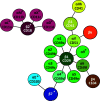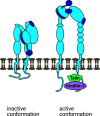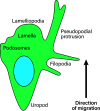β2-Integrins - Regulatory and Executive Bridges in the Signaling Network Controlling Leukocyte Trafficking and Migration
- PMID: 35529883
- PMCID: PMC9072638
- DOI: 10.3389/fimmu.2022.809590
β2-Integrins - Regulatory and Executive Bridges in the Signaling Network Controlling Leukocyte Trafficking and Migration
Abstract
Leukocyte trafficking is an essential process of immunity, occurring as leukocytes travel within the bloodstream and as leukocyte migration within tissues. While it is now established that leukocytes can utilize the mesenchymal migration mode or amoeboid migration mode, differences in the migratory behavior of leukocyte subclasses and how these are realized on a molecular level in each subclass is not fully understood. To outline these differences, first migration modes and their dependence on parameters of the extracellular environments will be explained, as well as the intracellular molecular machinery that powers migration in general. Extracellular parameters are detected by adhesion receptors such as integrins. β2-integrins are surface receptors exclusively expressed on leukocytes and are essential for leukocytes exiting the bloodstream, as well as in mesenchymal migration modes, however, integrins are dispensable for the amoeboid migration mode. Additionally, the balance of different RhoGTPases - which are downstream of surface receptor signaling, including integrins - mediate formation of membrane structures as well as actin dynamics. Individual leukocyte subpopulations have been shown to express distinct RhoGTPase profiles along with their differences in migration behavior, which will be outlined. Emerging aspects of leukocyte migration include signal transduction from integrins via actin to the nucleus that regulates DNA status, gene expression profiles and ultimately leukocyte migratory phenotypes, as well as altered leukocyte migration in tumors, which will be touched upon.
Keywords: LFA-1; RhoGTPases; actin tread milling; amoeboid migration; epigenetics; leukocyte migration; β2-integrins.
Copyright © 2022 Guenther.
Conflict of interest statement
The author declares that the research was conducted in the absence of any commercial or financial relationships that could be construed as a potential conflict of interest.
Figures






Similar articles
-
β2 Integrins-Multi-Functional Leukocyte Receptors in Health and Disease.Int J Mol Sci. 2020 Feb 19;21(4):1402. doi: 10.3390/ijms21041402. Int J Mol Sci. 2020. PMID: 32092981 Free PMC article. Review.
-
Distinct Migratory Properties of M1, M2, and Resident Macrophages Are Regulated by αDβ2 and αMβ2 Integrin-Mediated Adhesion.Front Immunol. 2018 Nov 15;9:2650. doi: 10.3389/fimmu.2018.02650. eCollection 2018. Front Immunol. 2018. PMID: 30524429 Free PMC article.
-
Beta2-Integrins and Interacting Proteins in Leukocyte Trafficking, Immune Suppression, and Immunodeficiency Disease.Front Immunol. 2019 Feb 19;10:254. doi: 10.3389/fimmu.2019.00254. eCollection 2019. Front Immunol. 2019. PMID: 30837997 Free PMC article. Review.
-
Leukocyte integrin expression in patients undergoing cardiopulmonary bypass.Ann Thorac Surg. 2000 Apr;69(4):1192-7. doi: 10.1016/s0003-4975(99)01553-2. Ann Thorac Surg. 2000. PMID: 10800818 Clinical Trial.
-
Integrins in Health and Disease-Suitable Targets for Treatment?Cells. 2024 Jan 23;13(3):212. doi: 10.3390/cells13030212. Cells. 2024. PMID: 38334604 Free PMC article. Review.
Cited by
-
Integrin Alpha8 Beta1 (81): An In-Depth Review of an Overlooked RGD-Binding Receptor.Biocell. 2025;49(5):789-811. doi: 10.32604/biocell.2025.062325. Epub 2025 May 27. Biocell. 2025. PMID: 40510035 Free PMC article.
-
Amoeboid migration in health and disease: Immune responses versus cancer dissemination.Front Cell Dev Biol. 2023 Jan 5;10:1091801. doi: 10.3389/fcell.2022.1091801. eCollection 2022. Front Cell Dev Biol. 2023. PMID: 36699013 Free PMC article. Review.
-
Complement System and Adhesion Molecule Skirmishes in Fabry Disease: Insights into Pathogenesis and Disease Mechanisms.Int J Mol Sci. 2024 Nov 14;25(22):12252. doi: 10.3390/ijms252212252. Int J Mol Sci. 2024. PMID: 39596318 Free PMC article. Review.
-
The Interplay between Integrins and Immune Cells as a Regulator in Cancer Immunology.Int J Mol Sci. 2023 Mar 24;24(7):6170. doi: 10.3390/ijms24076170. Int J Mol Sci. 2023. PMID: 37047140 Free PMC article. Review.
-
Editorial: Adhesion molecules and autoimmune diseases.Front Immunol. 2022 Aug 18;13:1009708. doi: 10.3389/fimmu.2022.1009708. eCollection 2022. Front Immunol. 2022. PMID: 36059500 Free PMC article. No abstract available.
References
Publication types
MeSH terms
Substances
LinkOut - more resources
Full Text Sources

